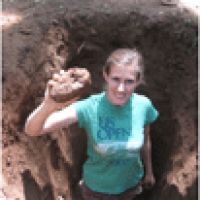White et al., 2018
Sediment flux rates by tree throw in the Shale Hills Critical Zone Observatory and associated satellite sites in the Appalachian Mountains
Timothy S. White*, Ashlee Laura Denton Dere, Sarah Sharkey (2018)
Abstract EP11D-2079 presented at 2018 AGU Fall Meeting, Washington, D.C., 10-14
-
National, Shale Hills, INVESTIGATOR, STAFF
-
Shale Hills, INVESTIGATOR, COLLABORATOR
-
National, STAFF
Abstract
Tree throw, the upheaval of soil and bedrock in the root mass of a fallen tree, is a major process in the overturn and downslope transport of soil and shallow bedrock in mountains. We report on measurements of tree throw at the Shale Hills Critical Zone Observatory (SSHO) and associated satellite sites in the central and southern Appalachian Mountains spanning from Alabama to New York. In our study, slope and prevailing wind direction, while important in places, did not control the majority of tree throw events. The depth to a root limiting layer and the distance from the center of a root wad to the center of an excavated pit increased from north to south – suggesting that deeper roots excavate more soil and deeper soils generally exist in warmer climates.
The basin-wide average sediment flux rate by tree throw determined from 479 tree throw measurements in the SSHO, an 8-hectare headwater catchment, is 2.8 x 10-3 m3 m-1 y-1. That rate is greater than the range of 8 x 10-5 m3 m-1 y-1 to 3.9 x 10-4 m3 m-1 y-1 determined from similar measurements from the five satellite sites in the Appalachian Mountains. While our observations double in number and verify formulations of sediment flux due to tree throw cited in the literature, the values exceed by several orders of magnitude values for sediment flux rate by soil creep on slopes.
Similar measurements made from a large tree blow down event that occurred adjacent to the SSHO in late summer 2017 help elucidate the disparity in values between the SSHO basin-wide average flux rate and the range of values determined from the satellite sites. Assuming a storm event duration ranging from hours to one day, we calculate instantaneous sediment flux rates by tree throw from the storm of 1.3 to 1.3 x 104 m3 m-1 y-1. The SSHO basin-wide data set can be binned by age of tree throw (determined in the field by assessing tree decay state) and is found to include a record of a time period in which sediment flux rate by tree throw reached 1.1 x 10-3 m3 m-1 y-1, exceeding other time bins by an order of magnitude. Therefore we suggest that the SSHO basin-wide average tree throw fluxes are skewed because data from a catastrophic event resides within the greater data set, and that a lesser value on the order of 10-4 m3 m-1 y-1 is most representative of stochastic sediment flux rates by tree throw in the temperate climate of the Appalachian Mountains.
Citation
Timothy S. White*, Ashlee Laura Denton Dere, Sarah Sharkey (2018): Sediment flux rates by tree throw in the Shale Hills Critical Zone Observatory and associated satellite sites in the Appalachian Mountains. Abstract EP11D-2079 presented at 2018 AGU Fall Meeting, Washington, D.C., 10-14 .
 This Paper/Book acknowledges NSF CZO grant support.
This Paper/Book acknowledges NSF CZO grant support.
Explore Further



